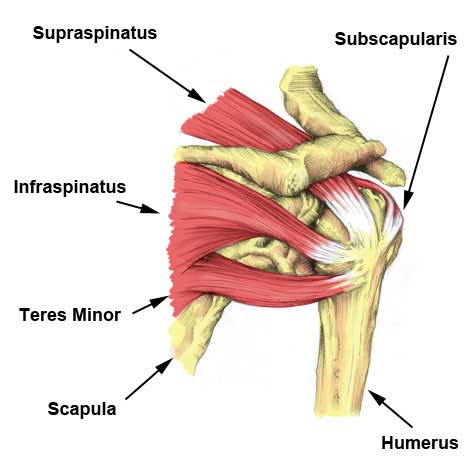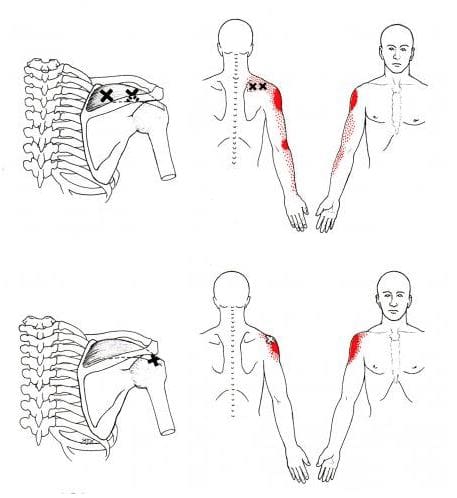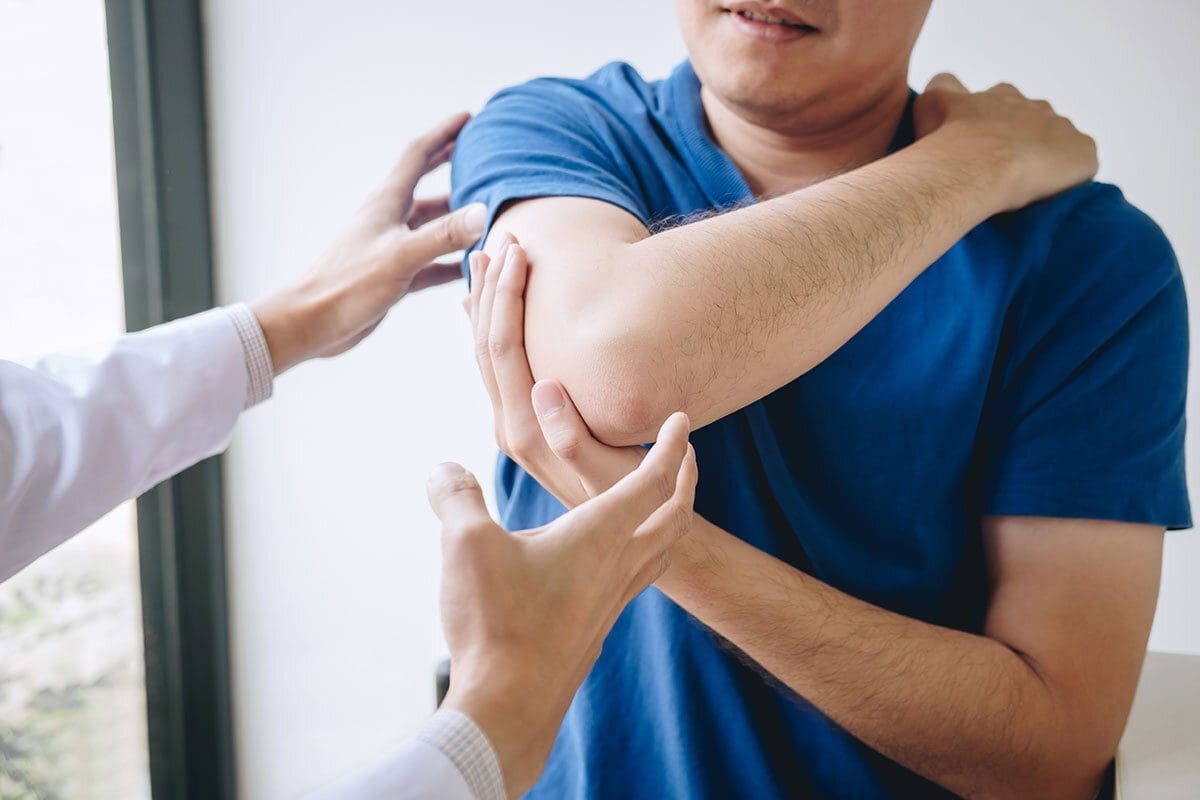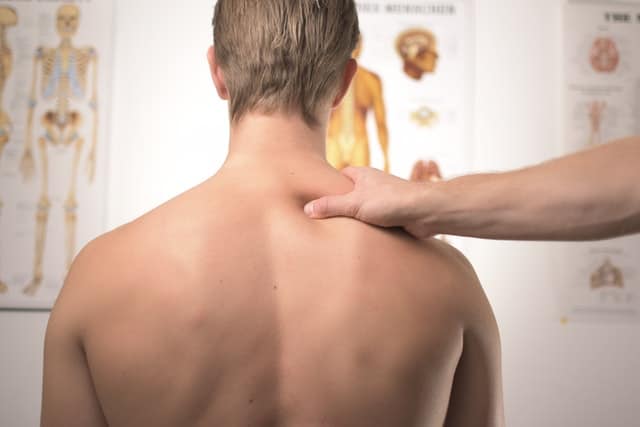Table of Contents
Introduction
The shoulder muscle functionality allows support and stability to the flexible joints in the body. The shoulders allow a full range of motion without feeling pain or discomfort, like throwing a ball or reaching an item on the shelf. The shoulders are also supported by many muscles, tendons, and ligaments surrounding the rotator cuffs that allow the shoulders to remain stable. The rotator cuffs consist of four muscle groups that allow the arms to be mobile. However, the range of motion from the shoulders and the rotator cuff can be prone to injuries and become unstable. To that point, the shoulders and their associated muscles are often the sites for many issues to develop. Today’s article looks at the supraspinatus muscles in the rotator cuffs, how trigger points affect the rotator cuffs and various therapies for rotator cuff injuries. We refer patients to certified providers who specialize in musculoskeletal treatments to aid individuals suffering from trigger points related to the shoulders affecting the rotator cuffs and the supraspinatus muscles. We also guide our patients by referring them to our associated medical providers based on their examination when appropriate. We ensure to find that education is the solution to asking our providers insightful questions. Dr. Jimenez DC observes this information as an educational service only. Disclaimer
The Supraspinatus Muscles In The Rotator Cuffs

Do you feel stiffness along your shoulders? Does it hurt when you rotate them? Or have you been experiencing numbness and tenderness traveling your upper arm? Individuals experiencing these symptoms in their shoulders could be dealing with trigger points along the supraspinatus muscles. The supraspinatus muscle resides in the supraspinous fossa of the scapular spine and is superiorly located in the rotator cuff muscles. The supraspinatus muscle is associated with the other muscles that surround and support the rotator cuffs in the shoulder, which include:
- Infraspinatus
- Teres Minor
- Subscapularis
These four muscles closely relate to the deltoid muscles to provide stability, movement, and rotation to the upper arm joint. When issues affect the shoulders or the rotator cuffs, it can cause the rotator cuff muscles to develop trigger points and other associated symptoms along the upper arm.
How Trigger Points Affect The Rotator Cuffs

When the muscles of the rotator cuffs become injured, many issues may cause musculoskeletal complaints. Studies reveal that tendinopathy or tendon injuries are often characterized by pain in and around the tendons in the rotator cuffs and are associated with repetitive actions. When the supraspinatus muscle becomes overused due to repetitive motions, it can develop trigger points to affect the rotator cuffs. Studies reveal that local and referred pain symptoms reproduce active trigger points in the muscles surrounding the shoulders and rotator cuff that many individuals recognize as familiar pain. According to Dr. Janet G. Travell, M.D., the activation of trigger points associated with the supraspinatus muscles are activated from strenuous activities like carrying heavy objects, walking a large dog that is pulling the leash, or lifting an object above shoulder height with the arms outstretched. These strenuous activities allow the trigger points to form along the supraspinatus muscles and cause referred pain symptoms on the shoulders.
Stretching The Supraspinatus Muscles- Video
Have you been feeling stiffness along your shoulders? Do you feel tenderness in certain areas of your shoulders or arms? Or do you experience a numbing sensation running down your arms? If you have been experiencing these issues along your shoulders and upper arms, it could be due to trigger points associated with the supraspinatus muscles. Trigger points are small knots along the taut muscle band of any muscle group that can mimic any overlapping condition that can cause issues to the body. For example, shoulder pain is associated with trigger points along the supraspinatus muscle. The video above shows how to stretch the supraspinatus muscles to reduce future trigger points from forming along the rotator cuff muscles. Individuals who incorporate stretching exercises for shoulder pain associated with the supraspinatus can feel relief in their shoulders as the overall function is restored and the pain is reduced.
Various Therapies For Trigger Points Associated With The Rotator Cuffs
The various therapies for trigger points associated with the rotator cuffs can help reduce the pain-like symptoms along the supraspinatus muscles. Studies reveal that exercises and manual therapy can help decrease pain along the supraspinatus muscles and increase shoulder muscle strength and function. Other treatments like chiropractic care can benefit many patients with shoulder pain or injuries that can help reduce pain, improve ROM (range of motion), increase flexibility, and even restore function to the joint. Depending on how severe the muscle injury is on the shoulders, chiropractors utilize various techniques to assess the pain and help address all the areas of the body to relieve the issue without using drugs.
Conclusion
The supraspinatus muscles are part of the rotator cuff muscle group and work alongside the shoulder muscles to provide mobility and a full range of motion to the upper arm without feeling pain. When strenuous activities or injuries occur to the shoulders or the rotator cuffs, it can cause myofascial pain syndrome or trigger points to develop along the overused muscles in the shoulders and cause pain-associated symptoms. This can affect the mobility of the shoulders and arms from going through a full range of motion. Various therapies are available to help reduce pain, restore functionality to the shoulders and surrounding muscles associated with trigger points, and can help improve motor function. Treatments for shoulder pain associated with trigger points can help prevent future issues from forming and improve shoulder functionality.
References
Hidalgo-Lozano, Amparo, et al. “Muscle Trigger Points and Pressure Pain Hyperalgesia in the Shoulder Muscles in Patients with Unilateral Shoulder Impingement: A Blinded, Controlled Study.” Experimental Brain Research, U.S. National Library of Medicine, May 2010, pubmed.ncbi.nlm.nih.gov/20186400/.
Jeno, Susan H, et al. “Anatomy, Shoulder and Upper Limb, Arm Supraspinatus Muscle.” In: StatPearls [Internet]. Treasure Island (FL), StatPearls Publishing, 7 Aug. 2021, www.ncbi.nlm.nih.gov/books/NBK537202/.
Spargoli, Guido. “Supraspinatus Tendon PATHOMECHANICS: A Current Concepts Review.” International Journal of Sports Physical Therapy, Sports Physical Therapy Section, Dec. 2018, www.ncbi.nlm.nih.gov/pmc/articles/PMC6253746/.
Şenbursa, Gamze, et al. “The Effectiveness of Manual Therapy in Supraspinatus Tendinopathy.” Acta Orthopaedica Et Traumatologica Turcica, U.S. National Library of Medicine, 2011, pubmed.ncbi.nlm.nih.gov/21765229/.
Disclaimer
Post Disclaimer
Professional Scope of Practice *
The information herein on "Trigger Points Affecting The Rotator Cuffs" is not intended to replace a one-on-one relationship with a qualified health care professional or licensed physician and is not medical advice. We encourage you to make healthcare decisions based on your research and partnership with a qualified healthcare professional.
Blog Information & Scope Discussions
Welcome to El Paso's Wellness blog, where Dr. Alex Jimenez, DC, FNP-C, a board-certified Family Practice Nurse Practitioner (FNP-C) and Chiropractor (DC), presents insights on how our team is dedicated to holistic healing and personalized care. Our practice aligns with evidence-based treatment protocols inspired by integrative medicine principles, similar to those found on dralexjimenez.com, focusing on restoring health naturally for patients of all ages.
Our areas of chiropractic practice include Wellness & Nutrition, Chronic Pain, Personal Injury, Auto Accident Care, Work Injuries, Back Injury, Low Back Pain, Neck Pain, Migraine Headaches, Sports Injuries, Severe Sciatica, Scoliosis, Complex Herniated Discs, Fibromyalgia, Chronic Pain, Complex Injuries, Stress Management, Functional Medicine Treatments, and in-scope care protocols.
Our information scope is limited to chiropractic, musculoskeletal, physical medicine, wellness, contributing etiological viscerosomatic disturbances within clinical presentations, associated somato-visceral reflex clinical dynamics, subluxation complexes, sensitive health issues, and functional medicine articles, topics, and discussions.
We provide and present clinical collaboration with specialists from various disciplines. Each specialist is governed by their professional scope of practice and their jurisdiction of licensure. We use functional health & wellness protocols to treat and support care for the injuries or disorders of the musculoskeletal system.
Our videos, posts, topics, subjects, and insights cover clinical matters, issues, and topics that relate to and directly or indirectly support our clinical scope of practice.*
Our office has reasonably attempted to provide supportive citations and has identified the relevant research studies or studies supporting our posts. We provide copies of supporting research studies available to regulatory boards and the public upon request.
We understand that we cover matters that require an additional explanation of how they may assist in a particular care plan or treatment protocol; therefore, to discuss the subject matter above further, please feel free to ask Dr. Alex Jimenez, DC, APRN, FNP-BC, or contact us at 915-850-0900.
We are here to help you and your family.
Blessings
Dr. Alex Jimenez DC, MSACP, APRN, FNP-BC*, CCST, IFMCP, CFMP, ATN
email: coach@elpasofunctionalmedicine.com
Licensed as a Doctor of Chiropractic (DC) in Texas & New Mexico*
Texas DC License # TX5807
New Mexico DC License # NM-DC2182
Licensed as a Registered Nurse (RN*) in Texas & Multistate
Texas RN License # 1191402
ANCC FNP-BC: Board Certified Nurse Practitioner*
Compact Status: Multi-State License: Authorized to Practice in 40 States*
Graduate with Honors: ICHS: MSN-FNP (Family Nurse Practitioner Program)
Degree Granted. Master's in Family Practice MSN Diploma (Cum Laude)
Dr. Alex Jimenez, DC, APRN, FNP-BC*, CFMP, IFMCP, ATN, CCST
My Digital Business Card



